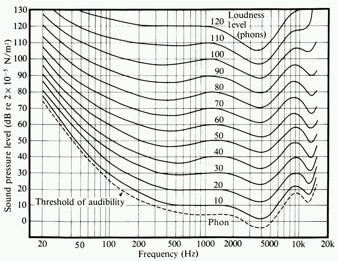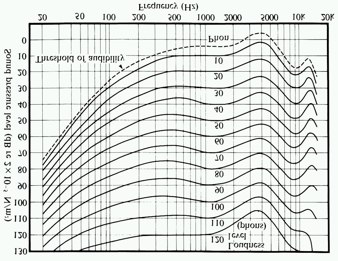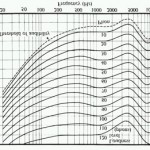
Harsh Reality: Part 1 – All Things Not So Equal

Fletcher-Munson Contours
I’ve been wanting to thrown down some thoughts on something for a while now, and Dave Rat’s latest video on EQ’ing a sound reinforcement system has provided actual motivation. Today I’m going to be talking about one of my favorite audio subjects. If you are streaming your services online using your FOH mix, I think this is important stuff to understand because it can bite you and is what I think might be one of the major challenges facing audio in church world right now.
So, quick refresher for those tuning in. One of the big concepts I’ve beat a drum on is the concept of a linear PA and optimizing to achieve this. Basically the theory is that what we deliver to the PA is what we should hear; the loudspeakers should sound just like the outputs of our console. This is kind of a big system tuning approach that a lot of big names get behind like Meyer, Scovill, McCarthy, etc, etc. Of course like many things in audio world, there are other approaches.
For example, I feel confident in saying that Dave Rat(Red Hot Chili Peppers, Rage Against the Machine) does not tune his PA to exhibit linear performance. I haven’t talked to Dave or even watched him tune his rig, but I have a good sense of this simply from his philosophies on tuning that he outlines in his video. Now I don’t think there’s anything wrong with how he tunes his rigs, and in fact, I’m starting to wonder if in some circumstances it might be a better approach.
So what clued me in on Mr. Rat’s optimizing preferences? Something very simple: his board tapes sound like CD mixes. In the world of sound reinforcement this doesn’t always work if you tune the PA linearly, and it’s basically a consequence of our good friend Equal Loudness. Equal Loudness is a concept I first learned about in college, and it’s something that has always interested me. I touched on this a few months ago, but today I want to start to dive into the stuff I’ve been dwelling on lately.
So, brief school lesson on equal loudness. Equal Loudness is all about perception and the way we perceive loudness of frequencies. Equal Loudness is basically the reality that we humans don’t perceive all frequencies equally when we hear different frequencies at the same measurable sound pressure level. This is a backwards concept at first glance because the reality is we don’t hear things equally. Our ears are NOT linear. However, the concept is referred to as Equal Loudness based on studies that have been done to measure how loud frequencies need to be for us to hear them equally.
The Fletcher-Munson contours displayed here are one of the first/more-famous studies done on equal loudness, and as I just mentioned, the curves display how loud a given frequency needs to be for us to perceive it at the same volume as another frequency on each contour. When the studies were done, they would typically play two tones for a subject: a 1k tone followed by another frequency. The subjects would then confirm when the two tones were perceived to be the same loudness. There have been more studies done over the years, but the Fletcher Munson graphs are easier to find on the internet and aren’t that far off from the current standard, ISO 226:2003.
Of course, the plot thickens with equal loudness as our overall sound level changes. If you look at the different contours, you will notice that our perception changes as volume increases or decreases. Basically, if we turn the volume up or down on our stereo, our perception of the spectral content of what we’re listening to will change. So, it’s almost like there is an EQ in our brain that changes dynamically as we’re exposed to different volumes. It’s wild stuff.

To better understand this, I like to look at the curves after flipping them. This way I can see what that brain EQ is actually doing. What I can see is that when things get louder(the lower contours), our perception tends to get more even, although we tend to get more sensitive to the 4 kHz area. When things get turned down, we gain increased sensitivity to low-mids in the 400-500 Hz range while that 4 kHz bump comes down a bit.
When I start to look closer at Equal Loudness and how it affects our hearing perception, it makes me wonder if the concept of having a perfect mix that sounds great at any volume is really achievable. Next up I’ll start looking at how this applies to us more specifically in Church World.

 Next Post
Next Post



Technically it should be possible to design a digitally controlled EQ of some sort that would take the overall material volume and modify the EQ to tune for ELC, right? So when playing a lower volume piece for the offering, or during a prayer time, it would bring the 400-500 range, say.
Thoughts?
In my experience, it’s not necessary to account for Equal Loudness when you’re in one environment. We’re very used to the effects of equal loudness so when something that was loud gets quiet, it doesn’t bother us so much. I think our brain naturally expects that change, and it can feel natural to us.
don’t really agree with dave on this one…
1. I never use my headphones in mixing live to reference anything other than whether I have signal or not.
2. It seems to me that one would tune your system to the room first, then bring the inst/vox/mics into the picture.
3. I don’t get trying to marry the two worlds together like Dave suggests.
Maybe I totally misunderstood what Dave was trying to say. In his world of going from festival to festival this might work for him, especially with the very limited time most of us get to “dial” it in at most festivals.
I’m with you, Matt. In the past I have typically only used headphones to check for signal. I think the touring world is a bit different than install because in touring you get the mix built, and then night to night it is more about tweaking the system to get the mix to work vs. reinventing the mix every night.
Hey Dave,
Firstly, thanks for the blog; saw that MSL tweeted something about it a while ago and have since been semi-following it.
Regarding Dave Rat’s video, and his philosophies in general, they seem to be based more on improving what he perceives subjectively than setting a goal and achieving it scientifically. This is a noble, tried and true method that can yield fine results; in my experience, though, if you begin by objectively optimizing a system, the results will be hugely more consistent. I do agree with him about using the system EQ for the system and the channel EQ for the channel, but I don’t think too many people would disagree with that.
Regarding flat responses versus not flat responses when tuning, I optimize every sub-system to flat so that when the engineer (which in some cases is me) plays a CD and makes subjective EQ changes they affect every audience member in the same way. I don’t believe that there is anything wrong with these subjective changes; they just belong on the other side of the art/science line.
Now, into the equal loudness contours: it is important to understand them in the sense that they explain why mixes have ‘tighter bass’ and ‘clearer highs’ when we bring them up in level. That said, I don’t think that they are as drastic as many engineers would have you believe; looking at the picture above, if you turn the level down 30 dB at 1k (from 100 to 70), it will only result in 5 dB of relative attenuation at 50 Hz – that ain’t much, and, in my opinion, not enough to warrant EQing different sections of a room differently. And have you been in any venue where the level difference between the loudest and quietest seat is 30 dB? I hope not! You might encounter a 30 dB difference between the venue and the people watching over the internet, but in this case I think that there are also much larger factors, like you’re in a large room with a fancy Meyer rig and they’re in front of a pair of tinny computer speakers.
My thoughts, for what they’re worth.
I will look forward to your next post. Rock on!
http://www.phys.unsw.edu.au/jw/hearing.html
Hey Dave,
Tried to listen in last night, but it was not streaming so well. I definitely have a few thoughts about the post above.
First, the equal loudness curves have been the subject of regular re-scrutiny in the scientific community at several points. The Fletcher Munson curves deviate substantially from the Robinson-Dadson curves, and both of these are different than the current best practices of ISO 266:2003, the latter probably being what you should have posted here.
Years of loudspeaker design and system tuning has helped me form personal best-practices that lie somewhere between dead flat and the equal loudness contours.
In general, when designing loudspeakers, it is helpful to have a clearly define target response, and I always choose that response to be the “flat” linear response. This is also the target response that I am for when someone pays me to tweak up proprietary or home-built boxes.
After a flat target has been established, only then do I return to the input side (not output side) equalization, and apply some of the tonal balancing that I have found to be generally effective, and only if the client would like this additional balancing.
In the low frequencies, the extra “oomph” that we usually add to the PA can be exciting. Subwoofer bandpass tuning balance, however, is somewhat genre-specific, however. Tuning large systems for electronic dance music, for instance, you will discover that the premiere acts in this space want a flatly tuned system, even in the low frequencies. Most rock mixers, however, will prefer some upward tilt that starts to become apparent just below 80Hz.
Since the low frequency response of a “pressure pot” increases at approximately 12dB an octave, and we as humans are used to LF augmentation in small spaces due to the pressure pot effect, I find that, in large rooms, the most satisfying LF tuning shows a gradual uptick in response all the way down to the low corner of the subwoofer bandpass. So if the LF cutoff of the subwoofers lies in the typical 40-45Hz regime, then the maximum LF boost will be just above the low corner frequency.
I have a bunch of other thoughts on this, but that’s probably better done in person. Let me know when you get down to the city next!
I’m not so sure you’re right about this…in theory, if a system is tuned linearly, everything should translate cleanly across formats. If your system is tuned to be as flat as possible, and your headphones are flat as possible, and your recorder, then any EQ you make to the audio should translate cleanly from format to format. The change you make in your cans reflects in the system, and if the system is flat and what you’re putting into it sounds good, then the recording sounds the same. Listening level and equal loudness is a playback issue, not a recording issue.
Now, Dave tunes by ear, and is not a big believer in measurement, so it’s not going to necessarily be ruler flat, but even with FFT it’s not going to be. And FFT should, of course, never be the deciding factor in system tuning. It’s a part of the process, but if the system sounds like crap after that, you’ve done something wrong, regardless of what the FFT says!
If you know you’re going to be playing back at a different level, you can EQ the feed to the board recording to compensate, but otherwise, flat is flat is flat.
–Andy